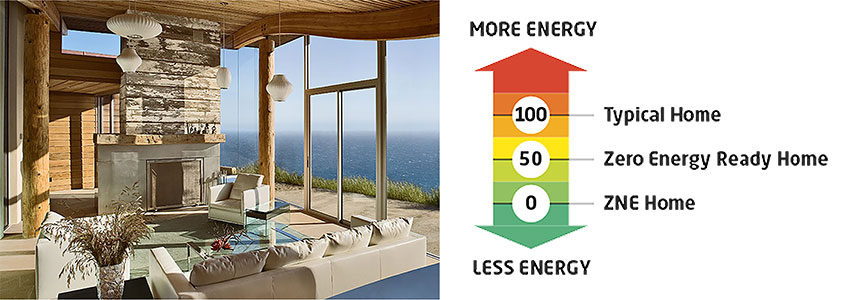A significant concern in the design or renovation of any building is how best to address the energy needs of the building operations. Architects have been successfully tackling this question through better building envelope design, specifying higher efficiency equipment, and tapping into renewable energy sources when possible. In the end, the building still needs energy, albeit at a hopefully reduced amount. The design professional is then faced with the question of what source of energy is best. Electricity is needed to power lights, outlets, and other appliances and equipment including air conditioning. Since the need for electricity is a given, there is a growing trend to extend electricity to all energy needs in the building, thus eliminating the need for any fossil fuel-powered equipment in the building. The intention behind this trend is to reduce the carbon footprint of the building significantly. There are two assumptions in that scenario; first that the electric grid that the building is connected to can meet the growing electrical demand of all electric buildings; second that the source of the electricity is “clean,” meaning that there is little or no environmental impact from its generation or transmission. There is also the implied desire for on-site energy to be generated through renewable sources. This course looks at these assumptions and investigates a hybrid option that combines grid-supplied energy with on-site energy from propane systems. The result can actually be cleaner than an all-electric design and, in the short term, can allow the electric grid to catch up to the ideal of fully renewable, clean energy.
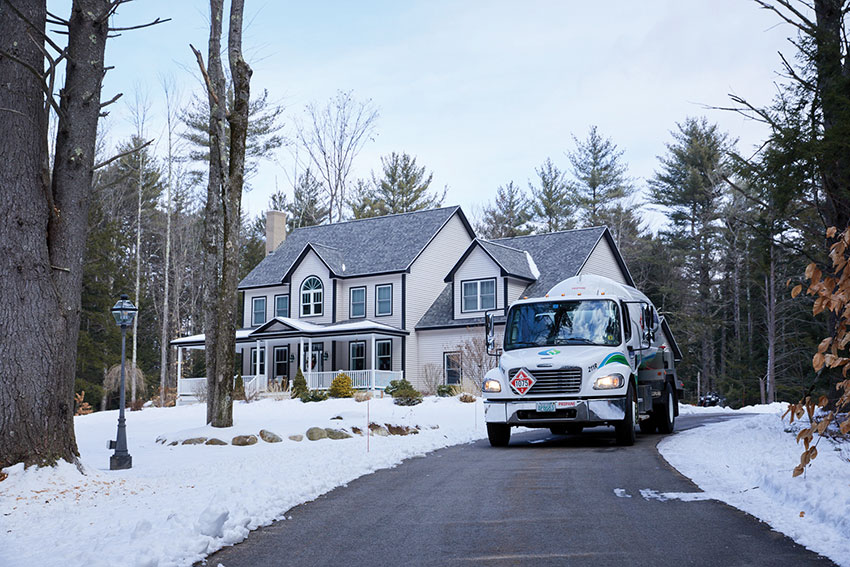
Photo courtesy of Propane Education & Research Council
Propane is a readily available and commonly used fuel source that can be combined with electrical systems of different types to create efficient and environmentally friendly energy solutions for buildings.
ELECTRICAL GRID STATUS
The U.S. electrical grid is easy to take for granted when connecting to any building. The assumption is that the local utility company is willing and ready to simply connect any building to its power distribution system. The reality is that all public electric utilities use a complex system of components to distribute electricity through decentralized units, substations, transformers, transmission lines, and distribution lines. The electricity itself is generated from centralized power plants that may or may not be owned by the electric utility. Building owners and consumers often have the choice of which source of electrical generation supplies their energy. That only works because the distribution system can connect to these different generation sources and track the amount of energy purchased from each. Collectively, we will refer to this whole, interconnected system in the United States simply as the electric grid.
The grid has been providing electricity since the early 1900’s with some major expansions and upgrades in the 1960s and 1970s. Across the country, the grid is divided into three main regions, namely, the Eastern (East Coast to the Rocky Mountains), Western (West Coast to the Rocky Mountains), and the Texas interconnections (State of Texas). Each one works within its region to provide power as needed to electrical customers, however connecting between them can be more problematic. This has been evidenced during recent storms and weather-related events where electricity could not be adequately provided because of the limits of the three regional systems. In addition, the electric grid has been criticized in recent years for its age and poor performance, particularly during heat-related blackouts and storms. There appears to be a need to upgrade older transformers, circuit breakers, and power lines, but doing so seems to be slow. In all, the availability of continuous, reliable electricity varies considerably across the USA in terms of capacity, interconnectivity, and controllability.
Electricity Generation
Turning to the generation of electricity, the U.S. Energy Information Administration (EIA) publicly reports annual data, with the latest numbers available from the year 2022 (October 2023 compilation). (see https://www.eia.gov/tools/faqs/faq.php?id=427&t=3) They identify three primary energy sources used by utility-scale electricity generation plants: 1) Fossil fuels, including natural gas, coal, and petroleum products, which still account for over 60 percent (2.5 trillion kilowatt hours) generated; 2) Nuclear power accounts for just over 18 percent (772 billion kilowatt hours) generated; and 3) Renewables, including wind, solar, hydropower, and biomass, which have grown to exceed nuclear power at over 21 percent (901 billion kilowatt hours) generated. In addition, the EIA estimates that an additional, much smaller amount of 61 billion kilowatt hours was produced from small-scale solar photovoltaic systems in 2022. While the slow but steady growth of renewable energy is welcome news in light of efforts to reduce harmful emissions, the reality is that the grid is still over 60 percent powered by fossil fuels. This production of electricity from fossil fuels still contributes to global warming/ climate change, acid rain, and air pollution.
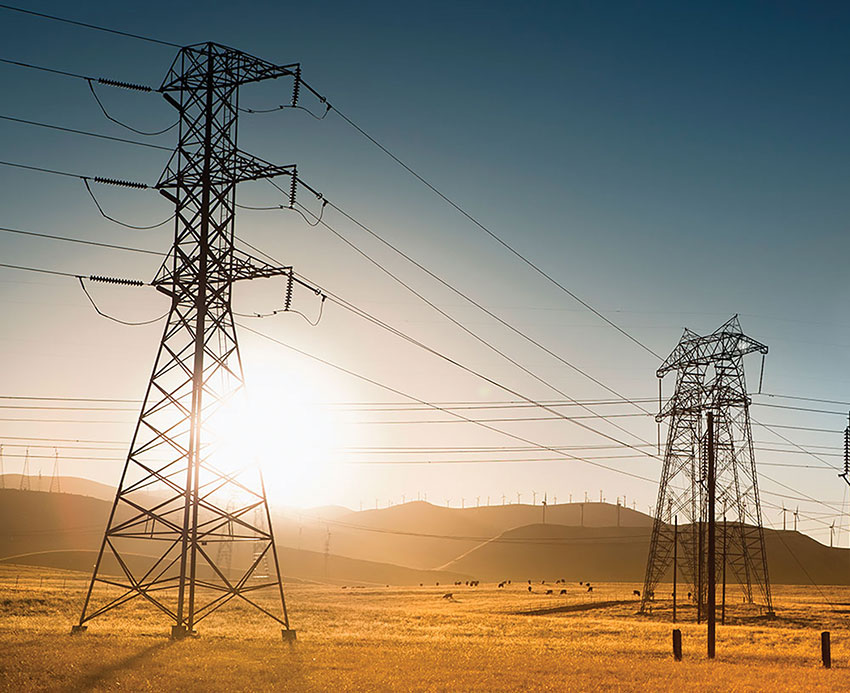
Photo courtesy of Propane Education & Research Council
The current status of the electrical grid in the United States has not yet reached the goal of providing environmentally friendly electricity in the most efficient and reliable manner possible.
Site vs. Source Energy
One of the biggest distinctions between utility-generated electricity and site-generated electricity is the overall efficiency of producing and delivering that energy. A number of energy and engineering organizations have made this distinction by using the terms site energy and source energy. Site energy is the amount of energy (typically electricity and other types) consumed by a building as metered and reflected in utility bills. Most building owners and designers look primarily at this site energy to understand how much energy an individual building is using at any given point in time or over the course of multiple months or years.
Source energy represents the total amount of energy contained before it ever hits the utility meter on a building. It takes into account the latent energy in the raw fuel, the efficiency (or lack thereof) in transforming that fuel into electricity, and subsequent energy losses that are experienced in the transmission and delivery of that electricity. Site energy use can be controlled by good design and the operation of the owner of the building. Source energy is subject to a host of variables including the fuel type, the age and efficiency of the generating plant, the make-up of the distribution system (i.e. the grid) and other factors. For typical fossil fuel-based electrical generation, from the site of production to use, the electricity generated is less than 30 percent efficient─that means 70 percent, or more, is lost in the process and only 30 percent or less is effectively used in the building. Hence, generating energy on-site has become considered one way to take back control of the total energy picture and improve the overall efficiency of energy use. That effectively means that less source energy is used so less of an impact can be created from the generation, delivery, and use of that energy.
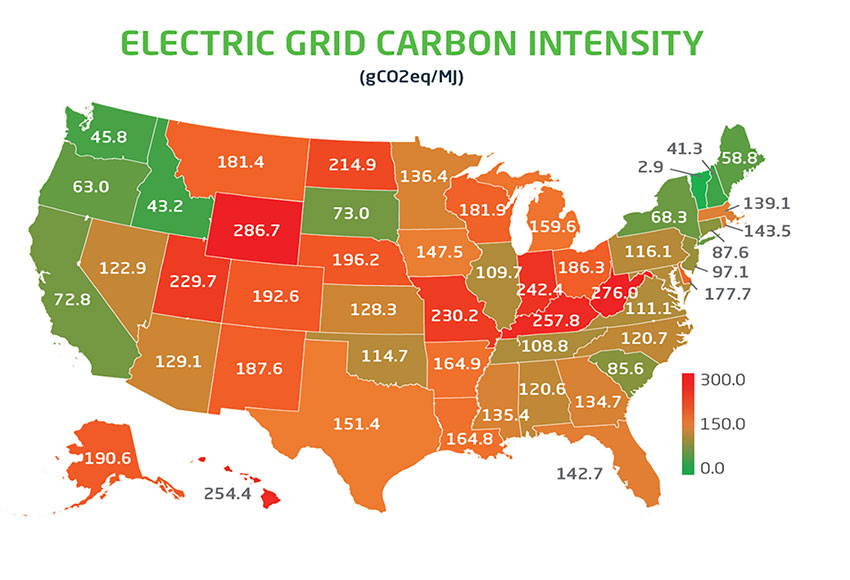
Image courtesy of Propane Education & Research Council
The carbon intensity of the electrical grid varies by state but is nonetheless rather high since coal and natural gas are still the primary fuels used for electrical generation.
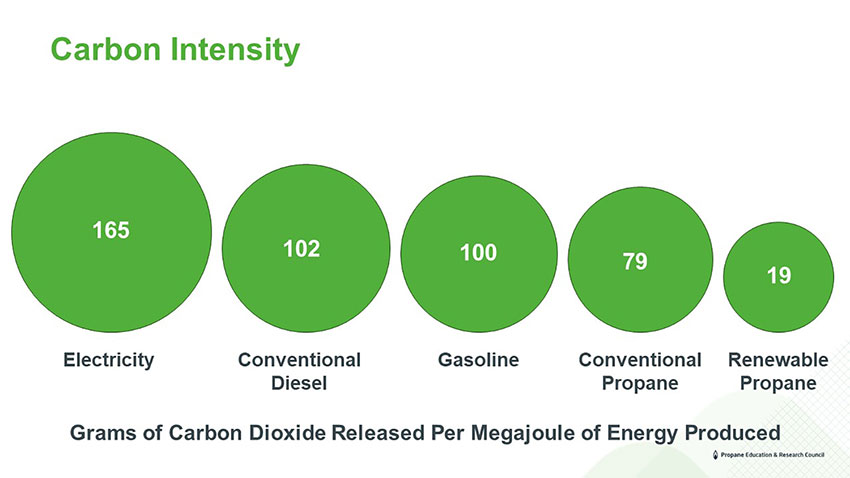
Image courtesy of Propane Education & Research Council
Propane’s carbon intensity includes the total carbon dioxide emissions from the production, transport, storage, and combustion of propane. Electricity’s carbon intensity includes the total carbon dioxide emissions from extracting resources (such as coal, natural gas, materials for solar panels and wind turbines, etc.), generation of electricity, transmission and distribution of electricity, and end use of electricity.
The Transition to Renewables
While the ideal of designing all-electric, non-polluting, energy-efficient buildings is being enthusiastically supported in many parts of the United States, the reality is that the current system of generating and distributing electricity isn’t there yet. Utility scaled generation by renewable energy is growing, but so is electricity demand for buildings, electric cars, and industry. Perhaps the best way to describe the current situation is one of transition – moving away from coal and other fossil fuels as they are replaced by cleaner, renewable energy options with less environmental impact.
One tool used to measure the real impact of different energy sources is referred to as carbon intensity, which is the total carbon emissions (or total carbon footprint) embodied in an energy choice from the source to the point of use. The units for carbon intensity are typically expressed in kg/MMBtu (million BTU) or grams/Megajoule. Based on our prior discussion, it should not be surprising to realize now that the electrical grid still has a rather high carbon intensity compared to the goal of a much lower one approaching zero.
During this transition, a more realistic goal should ultimately be how to best reduce the carbon intensity of the energy being used in a building. Architects can and should consider on-site generation from solar or wind when possible since it reduces or eliminates the inefficiencies and energy loss found in the grid. However, many building situations aren’t conducive to solar or wind systems due to space limitations, solar access, or other factors. There may also be limitations related to the building owner or local regulatory requirements. In some cases, those can be overcome through the use of community solar systems or selecting renewable energy from public utilities where available. In many cases, though, there needs to be another option.
A number of architects have begun to incorporate a hybrid energy approach into their building designs as a viable solution. This typically includes providing some amount of on-site renewable energy, most commonly solar electric, with another source that has a low carbon intensity. This combination creates a hybrid system that can be used to achieve short-term environmental goals while the longer-term solution is still evolving. Perhaps automobiles are a good analogy: hybrid gasoline/ electric cars have been in use for several decades helping with the transition to all-electric vehicles with readily available charging stations. In the same way, hybrid energy solutions in buildings can help move us closer to more environmentally responsible results.
PROPANE AS AN ENERGY ALTERNATIVE
One option worthy of consideration for creating a hybrid building design is the use of propane energy. Why propane? While it is true that it is a hydrocarbon, propane has a comparatively low carbon intensity for each unit of energy produced. Part of that is based on its chemical makeup and part on the efficiency of its distribution. In fact, the Energy Policy Act of 1992 lists propane as an acceptable “alternative fuel” along with biodiesel and liquified natural gas. Further, plant-based renewable propane is coming to be available with even less carbon intensity.

Image courtesy of Propane Education & Research Council
Propane is produced at central locations, distributed across the country, and stored locally for on-site delivery to buildings.
Propane as a Fuel
Propane, or as it is technically known, Liquefied Petroleum Gas (LP-gas or LPG) is a byproduct of either crude oil refining or natural gas processing. Once it is refined, there’s little difference between LP gases processed from these sources. The resulting propane is nontoxic, colorless, and naturally odorless so an identifying odor is added so it can be readily detected. For a number of years, over 99 percent of the propane used in the U.S. has been produced in North America. In fact, the US has available for export more than twice as much as is used in this country. In recent years, 30 billion gallons have been produced with 10 billion gallons being used and 20 billion gallons available for export. Hence, there is an abundance available.
Renewable Propane
After years of research and development, the propane industry now has another option available in the form of renewable propane. Unlike conventional propane, renewable propane can be made from a variety of renewable feedstocks. The most common form of renewable propane is a byproduct of renewable diesel and sustainable aviation fuel made primarily from plant and vegetable oils, animal fats, or used cooking oil. As such, renewable propane’s carbon intensity (i.e., the carbon emitted for every unit of energy it produces) is lower than conventional propane because it’s produced from bio-based or renewable sources.
An increasing amount of renewable propane is being generated from the seed oil of the camelina plant, also known as camelina sativa or false flax. Camelina is a member of the mustard family and a relative of cabbage, kale, and cauliflower, but it is not a food crop nor does it compete with food production. Camelina is grown in cooler regions of the U.S. and will likely expand to the South as producers are experimenting with varieties that can thrive in warmer climates. Camelina is drought and pest tolerant and is a pollinator for bees. This cover crop is completely waste-free as the seed produces 40% oil, twice the amount of soybean. The remaining meal is FDA approved for cow and chicken feed, and the husks are used for mulch. It is beneficial for farmers because it enriches the soil and prevents erosion when fields are fallow and provides additional income without the need for new equipment.
U.S. fuel processors are making renewable propane today, and the push for cleaner liquid fuels such as sustainable aviation fuel and renewable diesel fuel will lead to a sharp increase in renewable propane production. By 2050, renewable propane could meet half the world’s demand for propane, according to the World LP Gas Association. All of these efforts can help contribute to a more carbon-neutral world.
Propane Distribution
Part of the efficiency of distributing propane is that it can be stored and transported in either a liquefied state or as a gas. Propane producers use primary above-ground or below-ground storage systems to stockpile the available supply. From there it is shipped by pipeline, rail, or truck to thousands of secondary storage facilities throughout the United States. It is then accessed by propane retailers who are trained professionals located all over the country to provide propane service wherever there is a need.
At a specific building, propane is delivered, usually by truck, as a liquid and is pumped into an on-site storage tank which may be an above-ground or underground tank. If the tank is above ground, then the tank and any support system will be visible along with the needed valves, a pressure regulator, and a tank gauge. If it is underground, then typically the only visible portions are the cover which protects the shut-off valve, a regulator, a safety relief valve, and a tank gauge.
Using propane in the building is based on appliances and piping similar to using natural gas systems. Before leaving the on-site tank, the liquid changes to gas vapor and flows through a gas piping system to appliances inside and outside the home. The gas piping system commonly used in residential applications is pressure regulated at the tank with gas piping running underground to the home where further pressure regulation is usually needed to meet final appliance pressure requirements. The mounting of the regulator on the outside of the home must be planned with distance requirements from possible ignition sources.
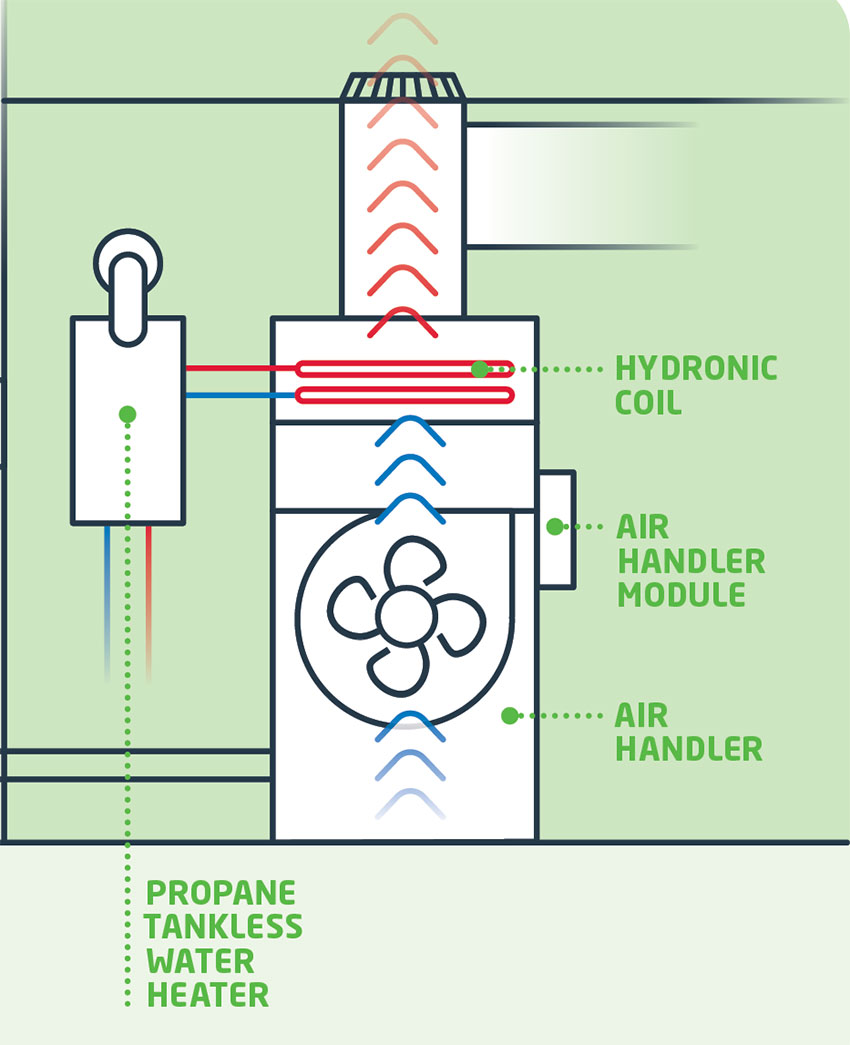
Image courtesy of Propane Education & Research Council
A hybrid heat pump system includes coordinated components that work together to provide electric heat when that is the most efficient and propane-powered heat in colder temperatures when that is more efficient.
Propane Safety
Propane has been in use for quite some time, so its safety aspects are well-known and documented. The National Fire Protection Association (NFPA) has taken the lead in developing codes and standards for the safe use, transportation, and installation of propane and related systems. In particular, NFPA 58 “Liquified Petroleum Gas Code” provides the requirements for safeguarding all LP gas (propane) installations in homes, businesses, and industrial settings. It also addresses the safe transportation of propane. This code is meant to help designers, health and safety managers, authorities having jurisdiction (AHJs), and insurance professionals address the particular details and conditions for safe LP gas use.
Relatedly, NFPA 54/ANSI Z223.1 “National Fuel Gas Code” applies to all fuel gas systems, of all types (i.e., not just propane), in and around buildings. This code recognizes everything from the risk of carbon monoxide poisoning to the potential for fire and explosion. Updated regularly, this code offers the latest comprehensive provisions for the safe design, installation, operation, maintenance, purging, and inspection of gas piping, equipment, accessories, and appliances supplied with any type of fuel gas.
Note that NFPA 54 is not the same as the International Fuel Gas Code (IFGC) prepared and issued by the International Code Council (ICC). This code similarly addresses the full range of fuel gases and all of the related system components. The IFGC does reference provisions from NFPA 58 specifically for propane systems but does not reference NFPA 54. Therefore, it can be important to verify which fuel gas code has been adopted in a given jurisdiction, either NFPA 54 or the IFGC. In either case, NFPA should be followed whenever the specifics of propane systems need to be addressed for safety and may also be adopted by a local jurisdiction.
Using Propane in Buildings
Keeping in mind all of the foregoing, propane can readily be used in buildings either as a stand-alone fuel source or as part of a hybrid energy strategy. It has been routinely used as a stand-alone solution, particularly in locations that either don’t have natural gas available (i.e. rural or edges of metropolitan areas). Of late, it has also been used where natural gas usage is being restricted by local regulations for environmental protection and/or in the interest of reducing fossil fuel use. In both of those cases, propane can help serve these locations with cleaner solutions for space heating, hot water production, cooking, or other residential and commercial uses.
When propane is used as part of a hybrid system, it can allow the building’s electrical system to be more appropriately sized and reduce upfront costs. In a residential or small commercial building, that could mean, for example, downsizing from a 400-amp electrical service to a 200-amp service. Hence, an on-site solar electric system may be able to provide most, or all of the remainder of the energy needs of the building. In addition to these energy aspects, on-site propane-based hybrid systems can increase resiliency by allowing building systems to keep running during power outages from the grid, especially if propane back-up generators are utilized.
CENTRAL HEATING SYSTEMS
Propane has been used for decades to fuel central heating systems in residential and light commercial buildings. When the focus is on moving heated air, propane-powered furnaces provide warm air at the discharge registers at a higher temperature providing the feeling of a quick warming effect. Condensing furnaces achieve high efficiency, take up less space than older systems, and require simpler flue and dedicated air intake. Hydronic radiant heating systems can alternatively be used to pump hot water from a propane boiler through in-floor or perimeter tubing systems, keeping the warmest air on the floor. The nature of this type of system is to heat the interior spaces evenly but more slowly than an air-based system. In some cases, the heating load may be small enough that the hydronic system is based on a smaller water heater or even a tankless water heater system. Larger spaces and buildings will rely on a more conventional or compact, high-efficiency boiler. Regardless of the specifics, any of these conventional systems are controlled by a thermostat to introduce the appropriate amount of heat when needed. While these systems are well-known and widely used, they are also being paired with electric heat pumps to create a hybrid solution.
Hybrid Heat Pump Systems
Air source electric heat pumps or so-called “split systems” are a popular source for home heating, particularly since they can readily provide heating and cooling in the same system. This makes them very appealing in warm climate zones, but they can encounter challenges in mixed and colder climates. While heat pump technology has been steadily improving in recent years, there are still limits requiring a heat pump system to turn on emergency or auxiliary heating. This is usually in the form of electric resistance heat that is very energy intensive and much less efficient than the regular heat pump operation. Even before the auxiliary heat kicks in, heat pumps can have comfort challenges, supplying air that feels cool.
Hybrid systems are designed to solve these challenges with the help of a propane back-up system. That back-up could be a conventional furnace providing heated air or a boiler providing heated water to a separate radiant system. A recent innovation is to use a propane-powered tankless water heater that is attached to a heat pump to replace the electric resistance back-up heating. This is accomplished by the use of a hydronic coil custom fit to match a heat pump air handler plus a circulating pump and a control module. The pump moves hot water from the tankless water heater to the hydronic coil, then the heat pump air handler fan blows air across the hydronic coil to heat the home. A hydronic air handler also provides a less extreme heat to help avoid stratification, in which the air close to a duct is much warmer than space farther away.
When the thermostat calls for auxiliary or emergency heat, the hydronic-based pump and tankless water heater come on instead of the heat strips. In this way, the air handler module communicates to a propane tankless water heater to circulate hot water through a hydronic coil that has been installed at the air handler. The results of this type of system include: 1) improved comfort since hybrid heat pump solutions can deliver heat faster and more consistently than all electric systems; 2) greater affordability compared to all-electric systems - hybrid heat pump solutions are cheaper to run than all electric systems using electric resistance back-up heating. They have been shown to reduce operating costs by up to 35 percent; 3) increase efficiency since hybrid heat pump solutions are energy efficient, requiring less electricity use and less overall energy consumption while still improving heating performance; and 4) design flexibility for architects and owners considering additions of solar- or wind-generated power. A hybrid heat pump solution can make installation more cost-effective due to the reduced electrical peak and running loads. All of these results will vary, of course, based on the particular details of a building’s location and design and should be reviewed and assessed accordingly.
In addition to the foregoing, when compared with a gas furnace, tankless hydronic heating offers the opportunity to use only one gas appliance that can provide both heat and domestic hot water. That means fewer vents and gas connections to install. It also allows a home to leverage the thermal efficiency of a tankless water heater, which can achieve efficiency levels of around 94 percent.
EFFICIENT PROPANE HOT WATER SYSTEMS
Propane can be an efficient means to produce hot water in many residential and small commercial settings. In addition to hybrid heating and domestic hot water systems, propane can also be used in a stand-alone domestic hot water system in either of two common ways:
Propane-tank-type water heaters This option has been commonly used to heat water using a gas burner instead of an electric heating element. Typically, propane tank water heaters can use the same connections, space, and venting as natural gas models. Of most interest to homeowners, propane heats water twice as fast as electricity and can cost up to a third less to operate over time.
Tankless water heaters This type of on-demand water heater avoids storing and reheating hot water by eliminating the tank. They operate by quickly heating water in a coil over high-output propane burners, then immediately circulating the heated water through the piping to the plumbing fixtures where it is being called for. By heating water only when needed in this way, it can reduce energy usage by up to 50 percent in some cases. That means the initial investment for a tankless propane water heater is typically offset within three years through lower operating costs. The cost is further reduced in many states that offer a rebate on the installation of propane appliances and by federal tax credits that are available for the installation of most propane tankless water heaters.

Photo courtesy of Propane Education & Research Council
Tankless hot water systems powered by propane can be more efficient and better suited to many residential designs compared to tank-type water heaters.
Tankless propane water heaters typically last for 20 years or more while tank-type water heaters are known to have a comparatively shorter expected useful life. Relatedly, a tankless propane water heater frees up 93 percent of the space used by a tank-type water heater. Finally, propane tankless water heaters provide an endless supply of hot water that is not restricted by tank capacity. Locating the tankless heater close to the fixtures requiring hot water can also reduce water usage where owners or occupants are “waiting for the hot water to reach the fixture.”
When looking at domestic hot water systems, the best results can be obtained by considering all available options, reviewing propane piping requirements, and verifying the needed controls for the solution selected.
PROPANE-BASED GENERATORS
Power outages from the grid have become more of a concern to a growing number of people around the country. Some of these concerns are based on an increase in weather-related storm events, wildfires, or other natural disasters being intensified by climate change. Other concerns can arise from chronic problems with portions of the grid that need updating or modernization. This can also be the case as more homes are built farther from municipal power lines or where electric power is less reliable or completely unavailable. Either way, there is a need for buildings that are designed to increase the resilience of the people who occupy them and allow for them to function safely again in light of these concerns.
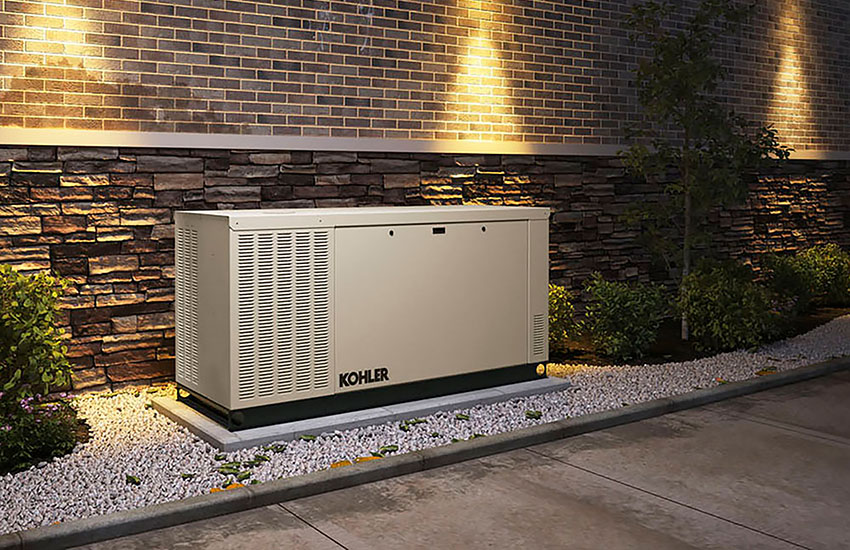
Photo courtesy of Propane Education & Research Council
Propane-powered generators can start automatically and provide reliable back-up electricity during a power outage.

Photo courtesy of Propane Education & Research Council
Propane powered combined heat and power systems offer a complete energy solution to address all of the energy needs of a building.
Stand-by generators have been used in many commercial buildings for years with the interest of providing emergency power for critical operations in a community. Homeowners have followed suit in recent times as residential-sized systems have become available and more affordable. These generators improve homeowner resilience by keeping electricity available during a power outage and helping to avoid a loss of critical operations at home too. Such generators can also be the primary electricity source where an “off-grid” solution is needed. Where desired, they can be paired with an on-site solar or wind system to provide electricity beyond the capability or availability of the sun or wind.
When considering the options for powering such an on-site generator, propane generators can be considered based on a number of notable attributes. First, they are normally designed to turn on automatically when the power from the grid is interrupted. Second, they have more advantageous characteristics compared to diesel or gasoline-powered generators. Most notably, propane burns cleaner than diesel and gasoline and a propane-powered generator has been shown to be more reliable than gasoline generators. Third, they run quieter than gasoline or diesel generators - many propane generators operate at less than 60 decibels which is about the volume of a normal conversation.
Selecting propane as the fuel means it can be stored on-site without deteriorating over time. If the rest of the house is using propane for other reasons, then the propane storage tank for the home can be sized to accommodate all of the needs accordingly–a separate storage tank isn’t required. Overall, propane generators are very straightforward to install and easy to operate and maintain.
COMBINED HEAT AND POWER SYSTEMS
In many building situations, particularly large homes or smaller light commercial applications, the owners see the value in having a combination of space heating and electrical power being generated from the same equipment. Combined heat and power (CHP) systems have been engineered and fabricated to produce both heat and electricity at peak efficiency. These CHP units use a generator to produce electricity, while also capturing heat that can be used to warm air and water. The result is reduced energy expenditures, eliminating efficiency losses between power plants and buildings, leading to a lower carbon footprint. Essentially, they create an onsite, environmentally friendly, affordable, and reliable energy source independent of the electric grid. Just as with onsite generators, propane offers the same cleaner, quieter, solution for CHP compared to systems that rely on gasoline or diesel fuel. Where resilience and independence from other energy sources are needed, propane-fueled CHP systems can be a viable alternative.
Although CHP systems are more common in commercial and industrial applications, the technology is emerging for residential uses too. Units in the 1–3-kilowatt range can provide heat and power for a standard 1,800-square-foot home. Larger homes with greater demands including a pool, or multi-family dwellings would require a unit of 3-10 kilowatts of power. CHP systems can also be designed to work in tandem with other energy sources, including traditional electricity and renewable energy sources like wind and solar, and still provide back-up power and heat as needed.
Overall, propane-powered CHP systems can be designed as an environmentally friendly, affordable, and reliable energy source that won’t go down with the electric grid.
CONCLUSION
Architects face a lot of choices and decisions in the quest to design buildings that are architecturally compelling and perform well in terms of energy use and environmental impact. While many options are available, there are also trends suggesting that all-electric solutions are preferable. However, as discussed here, the current realities do not yet seem to match up with ideal goals. Further, some building situations are not conducive to only grid provided electricity. Given the comparatively better environmental performance of propane compared to other options, and the emerging availability of renewable propane, systems that use this fuel are worthy of consideration. Design professionals can readily specify propane systems today in buildings where energy efficiency, resiliency, and reliability are part of the project requirements.
Peter J. Arsenault, FAIA, NCARB, LEED AP is a nationally known architect and a prolific author advancing better building performance through better design. www.pjaarch.com, www.linkedin.com/in/pjaarch

